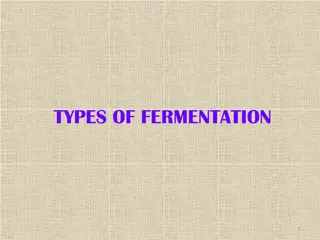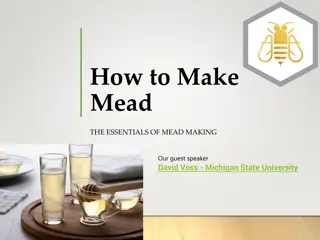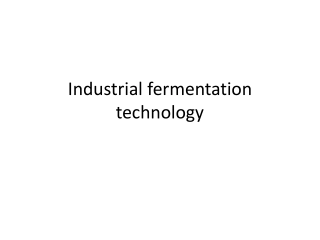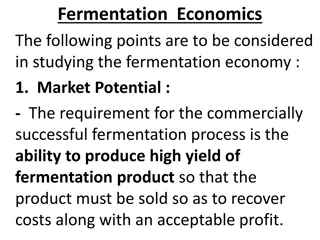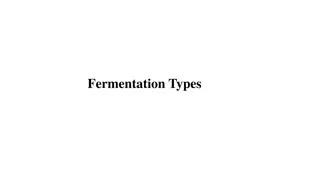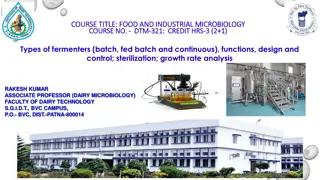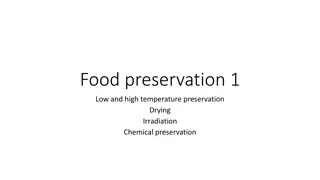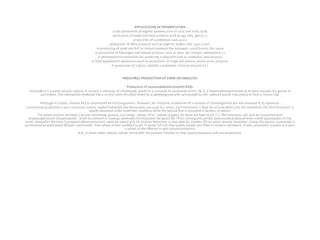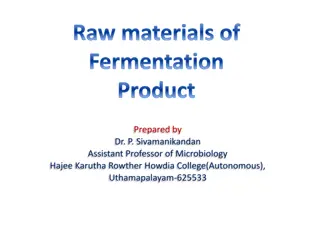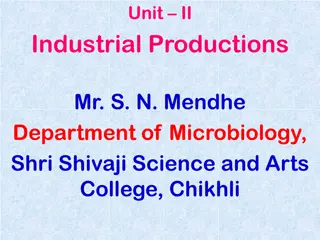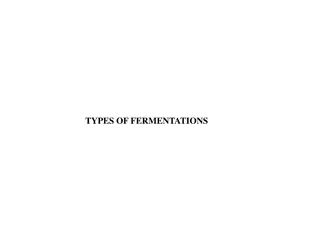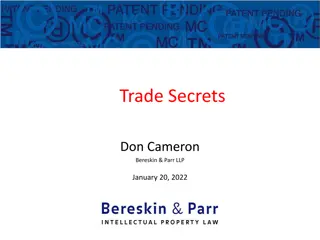Unveiling the Secrets of Mead: History, Making Process, and Fermentation
Delve into the world of mead, the ancient nectar of the gods, as we uncover its rich history dating back to the Paleolithic Period. Learn about the simple ingredients used in mead making, the role of yeast in fermentation, and the preservation benefits of this divine beverage. Explore the wisdom behind mead from Friar Tuck and discover why mead is considered the oldest fermented beverage.
Download Presentation

Please find below an Image/Link to download the presentation.
The content on the website is provided AS IS for your information and personal use only. It may not be sold, licensed, or shared on other websites without obtaining consent from the author. Download presentation by click this link. If you encounter any issues during the download, it is possible that the publisher has removed the file from their server.
E N D
Presentation Transcript
The Wisdom of Friar Tuck The Wisdom of Friar Tuck This is grain (honey), which any fool can eat, but for which the Good Lord intended a more divine means of consumption. Let us give praise to our Maker and glory to His bounty by learning about BEER (MEAD)!
The History of Mead The History of Mead Which is the oldest fermented beverage; Wine, Beer or Mead? Which is the oldest fermented beverage; Wine, Beer or Mead? Definitely Mead! Definitely Mead! How do we know this? How do we know this? Mead making dates back to the Paleolithic Period, 8000 BC. Mead making dates back to the Paleolithic Period, 8000 BC. Simple, uses only 3 ingredients, water honey & yeast. (no brewing required). Simple, uses only 3 ingredients, water honey & yeast. (no brewing required). Grapes not cultivated until much later. Grapes not cultivated until much later. The first mead likely the result of honey dripping from a hive into a pool of water. The first mead likely the result of honey dripping from a hive into a pool of water. Wild yeast fermented the honey into mead. Wild yeast fermented the honey into mead. Ancients observed strange behavior in animals drinking the honey water. Ancients observed strange behavior in animals drinking the honey water.
Fermentation; What & Why? Fermentation; What & Why? WHAT WHAT and carbon dioxide or the use of bacteria to create lactic acid in certain foods. and carbon dioxide or the use of bacteria to create lactic acid in certain foods. Fermentation is the use of yeast to change sugar into ethyl alcohol Fermentation is the use of yeast to change sugar into ethyl alcohol
Yeast is a living organism Yeast is a living organism Are a group of unicellular fungi. Are a group of unicellular fungi. Exist naturally in the air (good & bad wine years). Exist naturally in the air (good & bad wine years). Over 1,000 species Over 1,000 species Saccharomyces Cerevisiae is most commonly used in beer, wine and mead making. Saccharomyces Cerevisiae is most commonly used in beer, wine and mead making. Different subspecies produce different flavors and levels of sweetness. Different subspecies produce different flavors and levels of sweetness.
Fermentation; What & Why? Fermentation; What & Why? WHY WHY Preservation Preservation Lack of Refrigeration, alcohol inhibits decomposition. Lack of Refrigeration, alcohol inhibits decomposition. Used for centuries in Asia to preserve vegetables (Kimchee). Used for centuries in Asia to preserve vegetables (Kimchee). Lord Nelson s body preserved in a rum barrel at Trafalgar. Lord Nelson s body preserved in a rum barrel at Trafalgar.
Fermentation; What & Why? Fermentation; What & Why? Why Why Reduced bulk makes it easier and cheaper to move crops. Reduced bulk makes it easier and cheaper to move crops. Water was often not safe or attractive to drink. Water was often not safe or attractive to drink. Alcohol (along with heating during brewing beer) kills any harmful Alcohol (along with heating during brewing beer) kills any harmful organisms making it safe to drink (alcohol & the worm). organisms making it safe to drink (alcohol & the worm). U.S.S. Constitution Revolutionary War sailing manifest. U.S.S. Constitution Revolutionary War sailing manifest.
Is Mead Making Legal? Is Mead Making Legal? Yes! It is perfectly legal Yes! It is perfectly legal Legislation signed in by President Carter in 1979. Legislation signed in by President Carter in 1979. States may still regulate production. States may still regulate production. Florida allows a household to make 200 gallons per year. Florida allows a household to make 200 gallons per year. If a single adult household, 100 gallons per year. If a single adult household, 100 gallons per year. Distillation is still (no pun intended) illegal. Distillation is still (no pun intended) illegal. Freeze distillation is also illegal in Florida. Freeze distillation is also illegal in Florida.
Can I Sell the Mead I Make? Can I Sell the Mead I Make? Unless you have Federal and State licenses that allow you Unless you have Federal and State licenses that allow you to manufacture, transport and sell alcoholic beverages, to manufacture, transport and sell alcoholic beverages, NO! NO! That s called BOOTLEGGING! The mead you make is for your personal consumption. That s called BOOTLEGGING! The mead you make is for your personal consumption. You can however, give it away as long as the recipient is of legal age. You can however, give it away as long as the recipient is of legal age.
Mead Making Equipment Mead Making Equipment This equipment can also be used to make wine 6.5 Gallon Fermentation Bucket w/ Drilled and Grommeted Lid 6.5 Gallon Fermentation Bucket w/ Drilled and Grommeted Lid Complete Kit Complete Kit 6.5 Gallon Carboy (glass or plastic) with a drilled stopper and a brush 6.5 Gallon Carboy (glass or plastic) with a drilled stopper and a brush.
Mead Making Equipment Mead Making Equipment Sanitizers Sanitizers Liquid (Iodophor) Liquid (Iodophor) Oxygen (no rinse) Oxygen (no rinse) Economy Economy tsp in 1 quart water tsp in 1 quart water RINSE THOROUGHLY! RINSE THOROUGHLY! Uses iodine, stains equipment Uses iodine, stains equipment RINSE THOROUGHLY! RINSE THOROUGHLY! My Favorite! My Favorite!
Mead Making Equipment Mead Making Equipment Straight Racking Cane (bottling) Straight Racking Cane (bottling) Curved Racking Cane Curved Racking Cane Bottle Filling Tip Bottle Filling Tip Food Grade Tubing Food Grade Tubing Long Handled Spoon Long Handled Spoon Hose Clamp Hose Clamp
Mead Making Equipment Mead Making Equipment Airlock (1) Airlock (1) Airlock (2) Airlock (2) Thermometer Thermometer Hydrometer Hydrometer Test Jar Test Jar Bottle Caps Bottle Caps Corks Corks Hand Capper Hand Capper Hand Corker Hand Corker Wine Bottles Wine Bottles Beer Bottles Beer Bottles
Mead Making Equipment Mead Making Equipment Nice to have, but not necessary Nice to have, but not necessary Carboy Cap Carboy Cap Bottle Draining Tree Bottle Draining Tree Wine Thief Wine Thief Auto Siphon Auto Siphon Jet Bottle Washer Jet Bottle Washer Bottle Rinser Bottle Rinser
Mead Making Supplies Mead Making Supplies 12 12- -15 lbs Raw Honey. 15 lbs Raw Honey. Processed Honey will Processed Honey will NOT ferment. NOT ferment. Water, filtered or spring Water, filtered or spring Taste of water will affect Taste of water will affect the taste of the mead. the taste of the mead. Yeast (liquid) Yeast (liquid) Yeast Nutrient Yeast Nutrient Ensures yeast remains Ensures yeast remains healthy during fermentation. healthy during fermentation. Yeast Energizer Yeast Energizer Stimulates or restarts Stimulates or restarts Fermentation. Fermentation. Yeast (dry) Yeast (dry)
Mead Making Suppliers Mead Making Suppliers Local Local Just Brew It, 2670 Just Brew It, 2670- -1 1 Rosselle (904) 381 (904) 381- -1983, 1983, www.justbrewitjax.com www.justbrewitjax.com Rosselle ST., Jacksonville, FL 32204 ST., Jacksonville, FL 32204 Just Brew It, 1314 3 Just Brew It, 1314 3rd rd ST. North, Jacksonville Beach, FL 32250 ST. North, Jacksonville Beach, FL 32250 (904) 435 (904) 435- -4767 4767 Brew Bottle & Tap, 835 Park Ave., Orange Park, FL 32073 Brew Bottle & Tap, 835 Park Ave., Orange Park, FL 32073 (904) 375 (904) 375- -9123 9123 Internet Mail Order Internet Mail Order Northern Brewer, 6021 Northern Brewer, 6021 Lyndale (800) 681 (800) 681- -2739, 2739, www.northernbrewer.com www.northernbrewer.com Lyndale Ave. S., Minneapolis, MN 55419 Ave. S., Minneapolis, MN 55419 Leener s Leener s, 9293 (800) 543 (800) 543- -3697, , 9293 Olde 3697, www.leeners.com www.leeners.com Olde Eight Road, Northfield, OH 44067 Eight Road, Northfield, OH 44067
Mead Making Process Mead Making Process Primary Fermentation Primary Fermentation Sanitize all equipment, VERY IMPORTANT! Sanitize all equipment, VERY IMPORTANT! Yeast & bacteria love unfermented sugars. Yeast & bacteria love unfermented sugars. Not dangerous, nothing that can make you ill. Not dangerous, nothing that can make you ill. Can cause off flavors off flavors or spoilage. Can cause off flavors off flavors or spoilage. Place honey jars in a hot water bath so it will pour easily. Place honey jars in a hot water bath so it will pour easily. Fill fermentation bucket with 3 gallons of water at room temperature. Fill fermentation bucket with 3 gallons of water at room temperature. Add yeast nutrient according to instructions and stir before adding honey. Add yeast nutrient according to instructions and stir before adding honey. Bring 3 quarts of water to a boil. Bring 3 quarts of water to a boil. Pour honey into the fermentation bucket. Pour honey into the fermentation bucket. Use boiled water to dissolve remaining honey in jars and add to bucket. Use boiled water to dissolve remaining honey in jars and add to bucket.
Mead Making Process Mead Making Process Primary Fermentation Primary Fermentation Top up bucket with water bringing the volume up to 5 gallons (now called must). Top up bucket with water bringing the volume up to 5 gallons (now called must). Stir the must until all the honey is dissolved and well mixed (5 Stir the must until all the honey is dissolved and well mixed (5- -15 minutes). 15 minutes). Be sure and check the temp before adding yeast. Be sure and check the temp before adding yeast. Take a hydrometer reading and note specific gravity. Take a hydrometer reading and note specific gravity. Add yeast to the top of the must (no need to stir). Add yeast to the top of the must (no need to stir). Seal bucket and install a sanitized airlock. Seal bucket and install a sanitized airlock. Fermentation should start within 24 hours (bubbling airlock). Fermentation should start within 24 hours (bubbling airlock).
Mead Making Process Mead Making Process Secondary Fermentation (one to two weeks later) Secondary Fermentation (one to two weeks later) Bubbles will slow and stop in the airlock. Bubbles will slow and stop in the airlock. Confirm this with a hydrometer reading (should read near zero). Confirm this with a hydrometer reading (should read near zero). You may add Campden tablets to prevent further fermentation. You may add Campden tablets to prevent further fermentation. Siphon the mead into a sanitized carboy w/ airlock. Siphon the mead into a sanitized carboy w/ airlock. Leave behind as much sediment as you can. Leave behind as much sediment as you can. Let the mead clarify in the carboy. Let the mead clarify in the carboy. If you wish, add a fining agent such as Isinglass (collagen). If you wish, add a fining agent such as Isinglass (collagen). Bottle when the mead has cleared. Bottle when the mead has cleared.
Mead Making Process Mead Making Process Bottling Bottling Sanitize bottles, siphoning and bottling equipment. Sanitize bottles, siphoning and bottling equipment. Carefully siphon mead into bottles and cap/cork. Carefully siphon mead into bottles and cap/cork. Store in a cool dark place to age. Store in a cool dark place to age. Bottles may be consumed as early as 2 weeks after bottling. Bottles may be consumed as early as 2 weeks after bottling. Age for 6 months or more for the peak flavor (Black Palmetto Honey). Age for 6 months or more for the peak flavor (Black Palmetto Honey).
Mead Making Process Mead Making Process To Carbonate Or Not To Carbonate, That Is The Question? To Carbonate Or Not To Carbonate, That Is The Question? The Hard Way. The Hard Way. Dissolve honey into water . Dissolve honey into water . Stir into the mead before bottling. Stir into the mead before bottling. Be sure to use champagne bottles. Be sure to use champagne bottles. Seal with champagne corks & wire cages. Seal with champagne corks & wire cages. Age for 3 months to carbonate in the bottle. Age for 3 months to carbonate in the bottle. The Easy Way. The Easy Way. Buy a Soda Stream home soda maker. Buy a Soda Stream home soda maker. Pour finished mead into carbonation bottles and force carbonate Pour finished mead into carbonation bottles and force carbonate
Complex Meads Complex Meads Plain honey mead can be blended with fruit juices, wines herbs or grains to produce Plain honey mead can be blended with fruit juices, wines herbs or grains to produce Spectacular beverages. Each has it s own unique name and here are a few of them. Spectacular beverages. Each has it s own unique name and here are a few of them. Fruit Juices = Melomel Fruit Juices = Melomel Apples, apple juice, or cider = Cyser Apples, apple juice, or cider = Cyser Grape juice or wine = Pyment Grape juice or wine = Pyment Combined with spices = Hippocras Combined with spices = Hippocras Herbs or Spices = Metheglin Herbs or Spices = Metheglin Grains = Braggot Grains = Braggot Hydromel = Light Mead Hydromel = Light Mead Rodomel (Roman Empire) = Rose Petals Rodomel (Roman Empire) = Rose Petals
Suggested Reading Suggested Reading My Favorite My Favorite
In the words of Benjamin Franklin. In the words of Benjamin Franklin. Wine (Mead) is sure proof that God loves us and wants us to be Wine (Mead) is sure proof that God loves us and wants us to be happy. happy.


